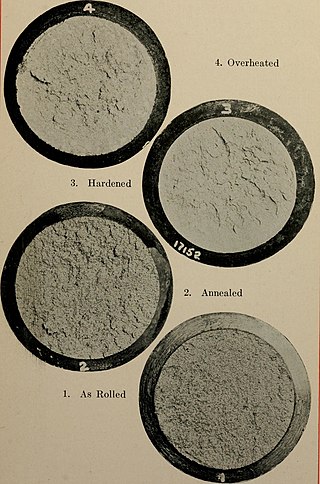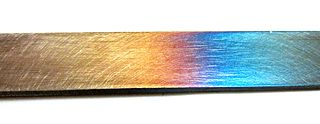Related Research Articles

Stainless steel, also known as inox, corrosion-resistant steel (CRES) and rustless steel, is an alloy of iron that is resistant to rusting and corrosion. It contains at least 10.5% chromium and usually nickel, and may also contain other elements, such as carbon, to obtain the desired properties. Stainless steel's resistance to corrosion results from the chromium, which forms a passive film that can protect the material and self-heal in the presence of oxygen.

Forging is a manufacturing process involving the shaping of metal using localized compressive forces. The blows are delivered with a hammer or a die. Forging is often classified according to the temperature at which it is performed: cold forging, warm forging, or hot forging. For the latter two, the metal is heated, usually in a forge. Forged parts can range in weight from less than a kilogram to hundreds of metric tons. Forging has been done by smiths for millennia; the traditional products were kitchenware, hardware, hand tools, edged weapons, cymbals, and jewellery.

Metalworking is the process of shaping and reshaping metals to create useful objects, parts, assemblies, and large scale structures. As a term it covers a wide and diverse range of processes, skills, and tools for producing objects on every scale: from huge ships, buildings, and bridges down to precise engine parts and delicate jewelry.
Aluminium–silicon alloys or Silumin is a general name for a group of lightweight, high-strength aluminium alloys based on an aluminum–silicon system (AlSi) that consist predominantly of aluminum - with silicon as the quantitatively most important alloying element. Pure AlSi alloys cannot be hardened, the commonly used alloys AlSiCu and AlSiMg can be hardened. The hardening mechanism corresponds to that of AlCu and AlMgSi. The rarely used wrought alloys in the 4000 series and the predominantly used cast alloys are standardised in the 40000 series.

Carbon steel is a steel with carbon content from about 0.05 up to 2.1 percent by weight. The definition of carbon steel from the American Iron and Steel Institute (AISI) states:

Tool steel is any of various carbon steels and alloy steels that are particularly well-suited to be made into tools and tooling, including cutting tools, dies, hand tools, knives, and others. Their suitability comes from their distinctive hardness, resistance to abrasion and deformation, and their ability to hold a cutting edge at elevated temperatures. As a result, tool steels are suited for use in the shaping of other materials, as for example in cutting, machining, stamping, or forging.

Die casting is a metal casting process that is characterized by forcing molten metal under high pressure into a mold cavity. The mold cavity is created using two hardened tool steel dies which have been machined into shape and work similarly to an injection mold during the process. Most die castings are made from non-ferrous metals, specifically zinc, copper, aluminium, magnesium, lead, pewter, and tin-based alloys. Depending on the type of metal being cast, a hot- or cold-chamber machine is used.

High-speed steel is a subset of tool steels, commonly used as cutting tool material.

Tempering is a process of heat treating, which is used to increase the toughness of iron-based alloys. Tempering is usually performed after hardening, to reduce some of the excess hardness, and is done by heating the metal to some temperature below the critical point for a certain period of time, then allowing it to cool in still air. The exact temperature determines the amount of hardness removed, and depends on both the specific composition of the alloy and on the desired properties in the finished product. For instance, very hard tools are often tempered at low temperatures, while springs are tempered at much higher temperatures.
Titanium alloys are alloys that contain a mixture of titanium and other chemical elements. Such alloys have very high tensile strength and toughness. They are light in weight, have extraordinary corrosion resistance and the ability to withstand extreme temperatures. However, the high cost of both raw materials and processing limit their use to military applications, aircraft, spacecraft, bicycles, medical devices, jewelry, highly stressed components such as connecting rods on expensive sports cars and some premium sports equipment and consumer electronics.

Nitriding is a heat treating process that diffuses nitrogen into the surface of a metal to create a case-hardened surface. These processes are most commonly used on low-alloy steels. They are also used on titanium, aluminium and molybdenum.

The SAE steel grades system is a standard alloy numbering system for steel grades maintained by SAE International.
Alloy steel is steel that is alloyed with a variety of elements in total amounts between 1.0% and 50% by weight to improve its mechanical properties.

A diamond tool is a cutting tool with diamond grains fixed on the functional parts of the tool via a bonding material or another method. As diamond is a superhard material, diamond tools have many advantages as compared with tools made with common abrasives such as corundum and silicon carbide.
A breaker bar is a long non-ratcheting bar that is used with socket wrench-style sockets. They are used to break loose very tight fasteners because their additional length allows the same amount of force to generate significantly more torque than a standard length socket wrench. Their use prevents damage to the ratcheting mechanism of a socket wrench. Often, after the first half turn, the fastener is loose enough to be turned with a socket wrench.

Mangalloy, also called manganese steel or Hadfield steel, is an alloy steel containing an average of around 13% manganese. Mangalloy is known for its high impact strength and resistance to abrasion once in its work-hardened state.

Uddeholms AB is a multinational producer of high alloyed tool steel with production in Hagfors, Sweden. Since 1991, the company is part of the Austrian Böhler-Uddeholm group which in turn is part of the voestalpine AG group since 2007. Uddeholms AB has 800 Swedish and 3,000 total employees.
Caldie is a chromium-molybdenum-vanadium alloyed tool steel manufactured by Uddeholms AB. It is intended for cold work processes, such as blanking and piercing, applied to difficult materials such as advanced high strength steel, where compressive strength and chipping and cracking resistance are important.
Cutting tool materials are materials that are used to make cutting tools which are used in machining but not other cutting tools like knives or punches.
References
- 1 2 3 Bayramoglu, M.; Polat, H.; Geren, N. (August 2008). "Cost and performance evaluation of different surface treated dies for hot forging process". Journal of Materials Processing Technology. 205 (1–3): 394–403. doi:10.1016/j.jmatprotec.2007.11.256.
- 1 2 3 "H13 Tool Steel". www.westyorkssteel.com. 2012. Retrieved 30 November 2016.
- ↑ Lorenz, H.P. (June 1995). "Investigation of TiN as an interlayer for diamond deposition on steel". Diamond and Related Materials. 4 (8): 1088–1092. doi:10.1016/0925-9635(95)00282-0.